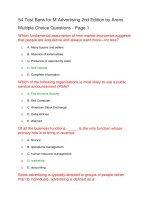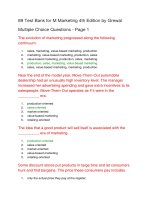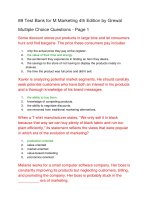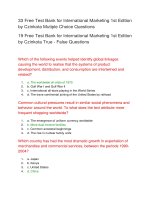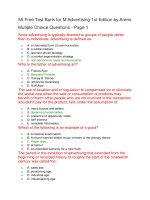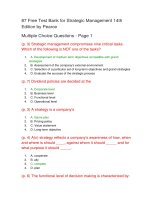Test bank for pharmacology for pharmacy technicians 1st edition by moscou
Bạn đang xem bản rút gọn của tài liệu. Xem và tải ngay bản đầy đủ của tài liệu tại đây (52.66 KB, 5 trang )
buy this full document at
Moscou: Pharmacology for Pharmacy Technicians
Test Bank
Chapter 1: Fundamentals of Pharmacology
TRUE/FALSE
1. Drugs come only from natural origins.
ANS: F
Drugs may come from natural or synthetic origin.
DIF:
Cognitive level 2: Interpretation
REF: p. 5
2. Erythropoietin is an example of a biopharmaceutical.
ANS: T
Erythropoietin and human insulin are examples of biopharmaceuticals.
DIF:
Cognitive level 1: Recall
REF: p. 3
3. Generic drugs are always less expensive than brand name drugs.
ANS: T
Generic drugs are always less expensive than brand name drugs.
DIF:
Cognitive level 2: Interpretation
REF: p. 8
4. “Rx only” must be printed on the label of all legend drugs.
ANS: T
“Rx only” must be printed on the label of all legend drugs.
DIF:
Cognitive level 1: Recall
REF: p. 8
5. Binders and fillers are inactive ingredients but have no influence rate of drug absorption.
ANS: F
Binders and fillers are inactive ingredients but they may influence rate of drug absorption.
buy this full document at
Full file at />DIF:
Cognitive level 2: Interpretation
REF: p. 10
MULTIPLE CHOICE
6. _____ drugs are only administered directly into the bloodstream.
a. Enteral
b. Transdermal
c. Transmucosal
d. Parenteral
ANS: D
Parenterally administered drugs directly enter the bloodstream, producing rapid action. Once in
the bloodstream, the side effects cannot be easily stopped.
DIF:
Cognitive level 1: Recall
REF: p. 12
7. Fentanyl is used as an _____.
a. anesthetic
b. analgesic
c. anticoagulant
d. antitussive
ANS: B
Fentanyl is a synthetically manufactured analgesic.
DIF:
Cognitive level 1: Recall
REF: p. 5
8. Which of the following statements about pharmacy technicians is not true: Pharmacy technicians
who possess a good understanding of pharmacology understand the importance of _____.
a. drug interactions
b. therapeutic duplications
c. lab values
d. excessive dose alerts
ANS: C
Knowledge of pharmacology facilitates selection of warning labels for drugs dispensed.
Pharmacy technicians who possess a good understanding of pharmacology understand the
importance of recognizing drug interactions, therapeutic duplications, and excessive dose alerts
screened by the computer
DIF:
Cognitive level 2: Interpretation
REF: p. 3
9. In 1906, the _____ was passed to protect the public from ineffective and harmful drugs.
a. Humphrey-Durham Amendment
Copyright © 2009 by Mosby, Inc., an affiliate of Elsevier Inc.
Full file at />b. Controlled Substance Act
c. Pure Food and Drug Act
d. Combat Meth Act
ANS: C
In 1906, the Pure Food and Drug Act was passed to protect the public from ineffective and
harmful drugs.
DIF:
Cognitive level 1: Recall
REF: p. 5
10. Which of the following drugs were not discovered in the 20th century?
a. antiinfective agents
b. insulin
c. antiretrovirals
d. castor oil
ANS: D
Antiinfective agents, insulin and its use for the treatment of diabetes, and antiretrovirals for the
treatment of HIV/AIDS were all discovered between the 1930s and present time.
DIF:
Cognitive level 1: Recall
REF: p. 3
11. The aim of drug therapy is to _____ disease.
a. diagnose
b. treat
c. cure
d. all of the above
ANS: D
The aim of drug therapy is to diagnose, treat, cure, or lessen the symptoms of disease.
DIF:
Cognitive level 2: Interpretation
REF: p. 5
12. Which step is not part of the drug development process?
a. clinical research
b. clinical studies
c. new drug application process
d. marketing
ANS: D
There are many steps in the drug development process. The steps from the test tube to production
and distribution of a new drug involve preclinical research, clinical studies, new drug application
process, and review.
Copyright © 2009 by Mosby, Inc., an affiliate of Elsevier Inc.
Full file at />DIF:
Cognitive level 2: Interpretation
REF: p. 5
13. The proprietary name of a drug is assigned by the _____.
a. FDA
b. CDER Labeling and Nomenclature Committee
c. New Drug Application reviewer
d. manufacturer
ANS: D
The proprietary name or brand name is assigned by the drug manufacturer according to
recommendations made by the CDER Labeling and Nomenclature Committee.
DIF:
Cognitive level 1: Recall
REF: p. 8
14. The Combat Methamphetamine Epidemic Act of 2005 (CMEA) was signed into law on March 6,
2006, to regulate, among other things, retail over-the-counter sales of _____.
a. ephedrine
b. pseudoephedrine
c. phenylpropanolamine products
d. all of the above
ANS: D
The Combat Methamphetamine Epidemic Act of 2005 (CMEA) was signed into law on March 6,
2006, to regulate, among other things, retail over-the-counter sales of ephedrine,
pseudoephedrine, and phenylpropanolamine products.
DIF:
Cognitive level 1: Recall
REF: p. 9
15. Chemical properties of the drug influence _____ of the drug in the body.
a. absorption
b. distribution
c. metabolism and elimination
d. all of the above
ANS: D
Chemical properties of the drug influence absorption, distribution, metabolism, and elimination
of the drug in the body.
DIF:
Cognitive level 1: Recall
REF: p. 10
MATCHING
Match the following drug endings with their classifications.
a. “-olol”
Copyright © 2009 by Mosby, Inc., an affiliate of Elsevier Inc.
Full file at />b.
c.
d.
e.
16.
17.
18.
19.
20.
“-prazole”
“-depine”
“-thromycin”
“-profen”
calcium channel blocker
β-adrenergic blocking drug
NSAID
macrolide anti-infective
proton pump inhibitor
16. ANS:
MSC:
17. ANS:
MSC:
18. ANS:
MSC:
19. ANS:
MSC:
20. ANS:
MSC:
C
DIF: Cognitive level 1: Recall
REF:
See Table 1-1 with common endings to official drug names.
A
DIF: Cognitive level 1: Recall
REF:
See Table 1-1 with common endings to official drug names.
E
DIF: Cognitive level 1: Recall
REF:
See Table 1-1 with common endings to official drug names.
D
DIF: Cognitive level 1: Recall
REF:
See Table 1-1 with common endings to official drug names.
B
DIF: Cognitive level 1: Recall
REF:
See Table 1-1 with common endings to official drug names.
p. 8
p. 8
p. 8
p. 8
p. 8
Match the following controlled substances with their schedule.
a. marijuana
b. methylphenidate
c. diazepam
d. diphenoxylate and buprenorphine
e. methyltestosterone
21.
22.
23.
24.
25.
C-III
C-II
C-V
C-I
C-IV
21. ANS:
MSC:
22. ANS:
MSC:
23. ANS:
MSC:
24. ANS:
MSC:
25. ANS:
MSC:
E
DIF: Cognitive level 1: Recall
Taken from Table 1-3 of controlled substance schedules.
B
DIF: Cognitive level 1: Recall
Taken from Table 1-3 of controlled substance schedules.
D
DIF: Cognitive level 1: Recall
Taken from Table 1-3 of controlled substance schedules.
A
DIF: Cognitive level 1: Recall
Taken from Table 1-3 of controlled substance schedules.
C
DIF: Cognitive level 1: Recall
Taken from Table 1-3 of controlled substance schedules.
REF: p. 9
REF: p. 9
REF: p. 9
REF: p. 9
REF: p. 9
Copyright © 2009 by Mosby, Inc., an affiliate of Elsevier Inc.
